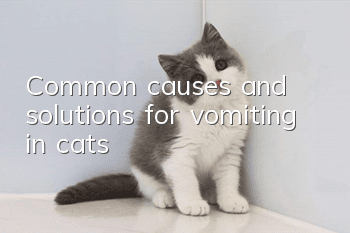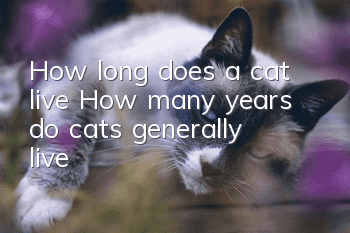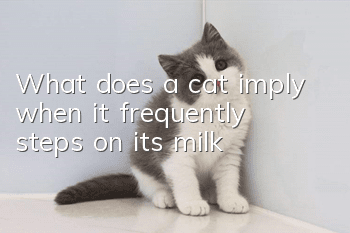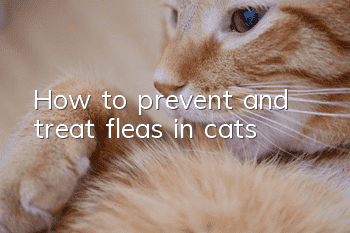Common causes and solutions for vomiting in cats

Vomiting is just a symptom and not the name of a disease, but vomiting is a common disease in cats. Sometimes cats vomit once or twice today and are full of energy the next day. Sometimes cats vomit very little but become less and less energetic. So under what circumstances do you need to take your cat to the hospital? Let us try to solve this difficult problem for you.
The "killer" behind vomiting no. 1 – clogged hair balls
It is well known that cats are very clean animals. The cat’s tongue is covered with many very small barbs, so when licking the hair, it can clean the dust and dirt on the body, and also clean the fallen hair. , to avoid the formation of hair knots and reduce the possibility of skin diseases. The hair will also produce vitamin D after being exposed to the sun, and licking the hair can help cats absorb calcium. From a behavioral point of view, another benefit of licking hair is to relax the mood. Cats licking their hair constantly is a sign of nervousness. By licking their fur, they understand the external environment and eliminate the smells they don’t like, which can relieve stress. .
So if your cat sheds a lot and you don’t take care of its hair every day, or there is a new member in the family, or it is boarding away from home, the increased stress will cause too much hair to be licked in, forming indigestible hair. If the hair ball cannot enter or pass through the intestines smoothly and is excreted from the body, the cat will have a normal physiological reaction. Vomiting is to spit out the hair ball. In order to vomit the hair ball, some cats will go to the grass to find vomiting grass to eat. .
Generally, what is vomited out at this time will be undigested cat food, or just retching. This kind of vomiting will not arouse the cat’s appetite. Soon after vomiting, the cat will want to eat, and its defecation and defecation will be normal. Symptoms of lethargy or low energy are just occasional vomiting.
Then the most convenient option to solve this kind of killer is to buy a hair removal cream and feed it to him. Hair removal cream is an ointment that can soften hair balls, a gastrointestinal softener, and has a good taste. If the cat is unwilling To eat, you can apply it on the cat's nose and let him lick it in. Of course, it is recommended that the owner go to the hospital to buy it when encountering this problem for the first time. This way, you can tell the doctor about your cat's clinical symptoms in detail for further judgment. That's right, then you don't have to bother the cat to go to the hospital. You can just buy hair removal cream or depilated cat food for him regularly in the future. However, the author has also encountered owners who think that the cat's vomiting is normal and leave it alone. , eventually causing hair balls to block the intestines and requiring surgery.
The killer behind vomiting no2 – foreign body
Young cats are very curious. Balls of thread, plastic bags, feather products, and sponge mats stained with the owner's scent at home are all the objects they chase and play with. This is a cat's nature - to hunt.During the game, they will bite the "prey", and they will eat the crushed plastic bags, feathers, and sponge pieces. The thread with the needle may be hooked by the kitten's small teeth or tongue. The barbs on the mouth are hooked, causing them to be unable to spit it out. Instead, they swallow deeper and deeper due to the discomfort in the mouth. These small fragments form clumps with the cat hair that the cat licks every day. If they are relatively small, they may be excreted by feeding hair removal cream or cooking oil. If the symptoms are not relieved after feeding, you will have to take them with you. Went to the hospital.
In this case, your cat’s appetite will become worse, eating less or even not eating, becoming less energetic, and unwilling to play or run. This is a very abnormal behavior for young cats. It is not only the cat food that will be vomited. There will also be clear water and yellow mucus. In this case, be sure to take your cat to the hospital for examination, palpation, gastrointestinal tract X-ray examination, gastric endoscopy, and most for the diagnosis of this disease. The rate is very high, and the next treatment plan will be formulated according to each different case. This kind of disease is most afraid of delaying the treatment time, so parents cannot choose to observe it at home because they feel sorry for the cat's stimulation. If the foreign body has already formed If it is clogged, the longer it lasts, the more serious the blockage may be.
The best solution is for parents who have kittens at home to please pack up these odds and ends, and the most important thing is not to eat them. The author once encountered cats that swallowed hairy crab ropes in clinic, and Cats that swallowed needles with threads ended up having to undergo surgery to remove them.
If unfortunately they accidentally eat you, take your kitten to the hospital as soon as possible.
The killer behind vomiting no3 – food poisoning
Relatively speaking, vomiting caused by food poisoning in cats is less common, but it cannot be ruled out
If the cat eats home food, the hot weather in summer will easily spoil the food, and various bacteria will multiply vigorously, which will often cause acute gastroenteritis and vomiting symptoms will usually occur. If the number of vomiting is not frequent and the cat still has appetite, you can observe it for a day without food or water. If it does not vomit, has appetite, and has normal bowel movements, you can choose not to go to the hospital. However, if your cat vomits more than three times a day, If you have no appetite, it is safer to go to the hospital for treatment.
Another type of food poisoning is caused by cats eating spoiled cat food that has been purchased through irregular purchase channels or has problems with storage methods. The cat food spoils and produces aflatoxin, causing poisoning. At present, 18 types of aflatoxin structures have been determined, including afb1, afb2, afm1, etc. Their basic structures contain difuran ring and oxonaphthalone (also known as coumarin). The former is its toxic structure, and the latter is May be related to its carcinogenesis. Generally speaking, a temperature of 30°C, a relative humidity of 80%, and a moisture content of grains above 14% (moisture content of peanuts above 9%) are most suitable for the reproduction and growth of Aspergillus aflatoxin. at 24-34℃Among them, Aspergillus flavus produces the highest amount of toxins. Almost all cereals can serve as aflatoxin substrates. Aflatoxin is very toxic and is the most toxic type of mold found so far. AFB1 is 68 times more toxic than arsenic and 75 times more potent than dimethylnitrosamine in inducing liver cancer. Its toxicity varies depending on the animal's species, age, gender, body condition, and nutritional status. Young animals and male animals are more sensitive.
Aflatoxin treatment can only be carried out in hospitals and is highly dangerous. Therefore, choosing the correct purchase channel and good storage methods can avoid this type of poisoning.
The killer behind vomiting no.4 – diseases of internal organs
Generally speaking, it is recommended that senior cats over 10 years old should have a physical examination every year, including blood routine and blood biochemistry, to check the health of the body organs. Of course, timid cats may not be able to do this, which requires the owner's care. Well, if the relationship between eating bad food or hair balls is ruled out, then internal diseases should be considered first.
Digestive tract diseases include acute gastroenteritis, pancreatitis, and exocrine pancreatic insufficiency. Symptoms of these diseases may include loss of appetite, vomiting, and abnormal bowel movements.
1. Many elderly cats have constipation problems. When a large amount of feces cannot be eliminated, toxins accumulate, ranging from not eating to vomiting in severe cases, using laxative therapy may not be effective.
2. Hepatobiliary diseases may show jaundice. At this time, the cat does not like to move, does not like to eat, always lies prone, and the superficial skin turns yellow.
3. Kidney disease will show abnormal water intake and abnormal urine output. In severe cases, toxins in the urine cannot be excreted and accumulate in the body, and vomiting may also occur.
Solution: The above-mentioned diseases must be taken to the hospital for treatment. The probability of internal diseases is higher than you think.
Although your baby may be timid and hide in the hospital every time, or hide and refuse to eat or drink when he comes home from the doctor to protest against you, as long as he is healthy, he can ensure that you and your Your pet can live a longer life, and many hospitals now have special cat wards. Pay more attention to them at ordinary times, and they can solve urgent needs when necessary.
- What should you pay attention to when raising cats and dogs together?
- Is it easy to raise a gradually folded cat?
- Does a tortoiseshell cat recognize its owner?
- Can cats take ibuprofen if they have a cold?
- Can cats take metronidazole if they are vomiting?
- Can domestic cats eat yogurt mixed with cat food?
- Can pet cats eat scrambled eggs?
- Cat sticks out tongue and vomits after smelling smelly feet
- Small pimples on cats
- How long does it take for a cat to suffocate if it is strangled?



